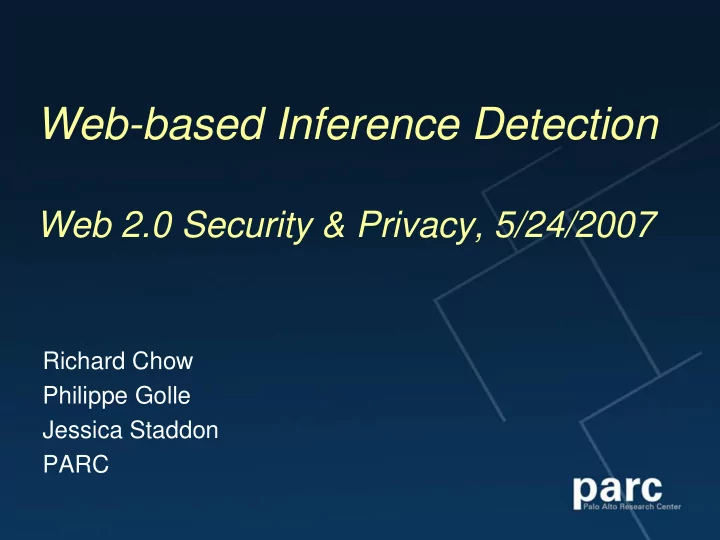

Web-based Inference Detection Web 2.0 Security & Privacy, 5/24/2007 Richard Chow Philippe Golle Jessica Staddon PARC
Declassified FBI Report
Web search on: “sibling saudi magnate”
Observations • Most web pages with terms “sibling saudi magnate” also contain terms “osama bin laden” • Hence, deduce the inference: {sibling saudi magnate} → {osama bin laden} • Get most valid inferences, since the Web is a proxy for all human knowledge – Not complete though! • Idea: Deduce inferences from co-occurrence of terms on the Web
Conceptual Framework • Consider any Boolean formula of terms, e.g. (saudi AND magnate AND sibling), (osama AND bin AND laden) • Evaluates to TRUE or FALSE for each Web page – Or, for each paragraph in each Web page... • Strength of inference: Conditional Probability – Given (PRECEDENT) is TRUE, what is probability that (CONSEQUENT) is TRUE? – Write: (PRECEDENT) IMPLIES (CONSEQUENT) • From now on, restrict to special case: Conjunction of terms implying another conjunction of terms – Other cases may be of interest as well: (xxx) IMPLIES (Person1 OR Person2 OR …)
Traditional Association Rules • Problem: Find market items that are commonly purchased together – Rules are of the form: (A) IMPLIES (B), A and B are sets of items – Legendary example: (diapers) IMPLIES (beer) • Confidence of a rule: Pr (B | A) – Given that A is purchased, how likely is B to be purchased? • Support of a rule: Pr( A and B) – What portion of all purchases contain both A and B? • Apriori (Agrawal et al): well-known algorithm for this problem – Works for given confidence and support cutoffs
Web Association Rules • Our problem: Find terms that are commonly found together on web pages • Key differences from traditional association rules – Web is very large and unstructured – Natural Language Processing (NLP) may provide additional information since we are mining terms from text – More complex rules are of interest • Boolean formulae such as (A) IMPLIES (B OR C) • Linguistic patterns such as (a followed b) IMPLIES (C) • Note that for privacy applications, need to find rules with very low support – Apriori algorithm not directly useful
Using search engines to estimate probabilities
Another Way Probability is about 81/234
HIV Precision: Top 60 Inferences • Precision: fraction of “correct” inferences produced • Analyzed top precedents appearing in at least 100K documents • Medical expert reviewed these inferences – 28 were “correct” – 3 not necessarily connected to HIV, but were related conditions – 29 unknown or did not indicate HIV • Medical expert appropriate for medical records - note that appropriate reviewer depends on the application – “ Montagnier” not considered “correct”, but was discoverer of the HIV virus – “Kwazulu” not considered “correct”, but this province of SA has one of the highest HIV infection rates in the world
Inference Problem • More and more publicly available data – Web 2.0 technologies becoming common – “long tail of the Internet” • How to control the release of data? – What does the data reveal? – Need automated techniques • Scenarios: – Individuals • Anonymous blogs or postings • Redaction of medical records – Corporations • News releases • Identification of content representing risk – Government • Declassification of government documents
Recommend
More recommend